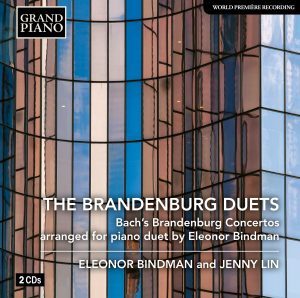Over the course of my work on arranging the Brandenburg Concertos many people would ask me: “Why not for 2 pianos?” Now that the project is completed and the recording has been released, I am still getting emails from fans of the new Brandenburg Duets CDs with the same question. Well, there are many reasons why and the teacher in me strives for thorough explanations, so here are a few paragraphs on the topic.
Of course, the question is perfectly legitimate, since two pianos would be much easier to work with when transcribing this piece, or any orchestral piece for that matter. No need to decide which string parts to omit completely, no need to transpose up or down an octave, no need to worry about density of texture in the middle register or about dividing a harpsichord cadenza between two players. It would have been easier to have an entire keyboard for each pianist: no bumping elbows, no deciding whose hand goes into an awkwardly high or low position, no issues of balancing register volumes or exact sound and touch matching when sharing the same theme. The sheet music would have been easier to print as well, without having to fit the same measure numbers for each page of Primo and Secondo and to print the hard copies of music back to back.
The overriding reason for this being a piano-4-hands arrangement is elementary: two pianos are much harder to come by than one. Think of how many times you have seen two pianos in the same room, unless you were in a concert hall or a music school. And now compare that to all the times you have seen one piano in a room, like in your own home, perhaps. You can play this music at home with a friend whenever you are both available, but imagine if you had to have two instruments? And for performances, bringing a second piano in for a concert always requires rental, extra tunings and (unless we’re talking about a major concert venue) moving/ transportation, ditto for a recording –all this means major expenses in a world were musicians barely get paid for anything. Incidentally, recording on 2 pianos is a lot more difficult than on one, as far as synchronicity goes.
My motivation for working on the Brandenburg Duets was to replace the old arrangement by Max Reger which was hastily done and has barely ever been performed. For the same practical reasons as above, his transcription was made for piano-4-hands, as were other transcriptions of Bach’s works, Beethoven’s symphonies, many opera overtures,etc.. There was a huge body of piano duet repertoire generated mostly in the 19th century when pianos were found in most bourgeois homes. Those duet transcriptions served the same function as the radios and records did in the 20th century: they made classical music accessible for the public’s enjoyment outside the concert hall.
All piano teachers know how important 4-hand playing is for one’s development as an ensemble player. Duets for beginners figure prominently in methods books, yet there isn’t much music for that medium written by great composers. Mozart’s Sonatas and Schubert’s works are the only extensive bodies of work that advanced students and adult amateurs can enjoy. I am hoping that Bach’s 6 Brandenburg Concertos – a total of 18 movements of the most wonderful and varied set of orchestral pieces ever transcribed for piano-4-hands – can give piano partners a new source of learning and enjoyment. The single-keyboard format dictates a thinner texture and therefore simpler parts for both pianists, suitable for intermediate/advanced levels. Some slow movements are very easy to coordinate, some fast ones are quite difficult and there are many in between. Many faster movements sound equally good at a slower tempo and may be used for exercises in finger dexterity and coordination. And playing this in such close proximity, next to one another, has a unique sensation and feeling of partnership in music for pianists who normally don’t find themselves so close to others in chamber music.
Lastly, for me personally, meeting the challenge of adapting the music well to one keyboard and two players was the real purpose of this project. The process exposed the complex polyphonic architecture of 6 very different pieces and somehow resulted in a version which seems to belong in our times as much as the original belonged in the 1700s. Bach’s music can be heard in a completely new way without losing its essence.

